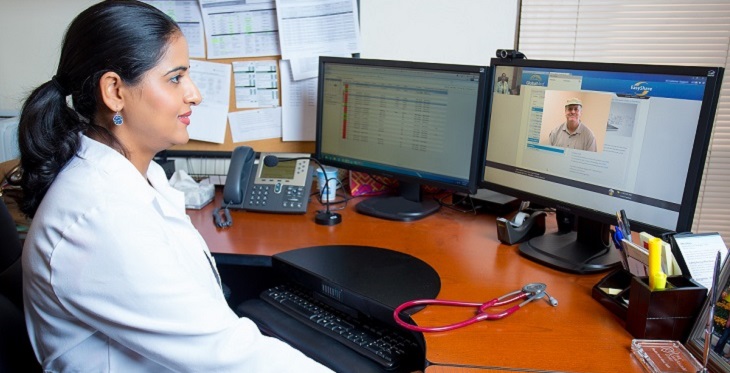Welcoming Telemedicine: Transforming Healthcare Distribution for a Modern Globe
The landscape of healthcare delivery is undergoing a significant shift driven by technological advancements, with telemedicine becoming a crucial element in this transformation. As we navigate an age characterized by quick digitalization and progressing client demands, the assimilation of telemedicine into conventional medical care practices provides an engaging proposal. This ingenious strategy not just holds the promise of enhancing access to care but additionally stands to revolutionize the dynamics of patient-provider communications. In exploring the implications and complexities of accepting telemedicine, a nuanced understanding of its multifaceted influence on health care delivery in the modern-day world comes to be critical.
The Development of Telemedicine
Telemedicine has actually undergone substantial advancement over the past couple of years, changing the landscape of medical care shipment. Initially conceived to link the space between doctor and people in remote locations, telemedicine has actually now broadened its reach to provide a large range of medical solutions through technological improvements.
In the onset, telemedicine mainly entailed appointments via telephone or video conferencing. Nevertheless, with the proliferation of digital devices and systems, health care professionals can now remotely keep track of essential indications, conduct online assessments, and even carry out certain clinical treatments. This shift in the direction of even more comprehensive online care has actually reinvented the method health care is provided, making it much more convenient and accessible for clients.
In addition, the integration of electronic wellness documents (EHRs) and telemedicine has actually boosted control amongst healthcare groups, causing much more reliable and joint individual treatment. Telemedicine reviews. With the recurring developments in synthetic intelligence and remote tracking devices, telemedicine is poised to continue progressing, offering ingenious solutions to enhance medical care end results around the world

Benefits of Telemedicine Fostering
As the use of telemedicine has expanded to encompass a wider spectrum of medical services and technological abilities, the advantages of its fostering in contemporary health care distribution have actually become significantly obvious. Among the main benefits of telemedicine is boosted accessibility to health care solutions, especially for individuals in remote or underserved areas. Clients can currently seek advice from healthcare carriers without the requirement for prolonged traveling, reducing both time and price obstacles. Additionally, telemedicine enhances convenience for people by enabling them to set up consultations at times that match their timetables, advertising better adherence to treatment strategies.
In addition, telemedicine can lead to improved wellness end results through improved care control. Telemedicine can assist reduce strain on typical health care systems by decreasing overcrowding in healthcare facilities and centers, ultimately enhancing general performance and person complete satisfaction.
Overcoming Telemedicine Challenges
Addressing the barriers integral in incorporating telemedicine into existing medical care systems presents an essential yet surmountable challenge for health care service providers worldwide. Convincing typical healthcare providers to take on telemedicine requires extensive training programs and continual support to ensure seamless assimilation.
Furthermore, regulatory barriers and repayment limitations posture significant challenges to the extensive execution of telemedicine. Numerous state and country policies relating to telemedicine methods create an intricate visit site atmosphere for providers to browse. Repayment plans that do not adequately compensate for telemedicine solutions can discourage healthcare companies from purchasing this cutting-edge technique to care delivery.

Enhancing Patient-Provider Communication
Browsing the landscape of telemedicine challenges brightens the important need for enhancing patient-provider interaction in modern-day healthcare delivery systems - Telemedicine reviews. Efficient interaction exists at the heart of high quality healthcare stipulation, and in the realm of telemedicine, where physical hints may be restricted, understanding and clear interaction comes to be much more critical
Enhancing patient-provider communication in telemedicine entails various techniques. Developing rapport and trust fund via active listening and compassion can aid cultivate a strong patient-provider relationship. Using protected messaging platforms or teleconferencing tools can promote routine and hassle-free interaction between carriers and clients. Supplying clear directions, establishing reasonable expectations, and making certain open lines of interaction for follow-up inquiries can enhance the general individual experience in telemedicine.
Future Trends in Telemedicine
Anticipating the evolution of telemedicine, advancements in innovation and medical care distribution systems are leading the way for ingenious techniques to patient care. One of the future trends in telemedicine is the combination of fabricated intelligence (AI) and artificial intelligence algorithms to improve analysis abilities. blog AI can examine large amounts of patient information rapidly, assisting doctor in making extra accurate diagnoses and treatment decisions. Additionally, the use of digital fact (VR) and enhanced reality (AR) in telemedicine is acquiring energy. These innovations can produce immersive experiences for both clients and companies, facilitating virtual assessments and clinical training simulations.
Additionally, the expansion of telemedicine solutions to underserved country and remote locations is an essential fad. By leveraging telemedicine, health care providers can reach clients in remote areas, improving access to quality treatment. Another pattern is the ongoing growth of remote surveillance tools and wearable modern technology, allowing for real-time tracking of person wellness metrics from a distance. These advancements in telemedicine hold terrific promise for changing medical care distribution and improving individual outcomes in the future.
Conclusion
In verdict, telemedicine has actually transformed healthcare delivery by enhancing access to care, enhancing efficiency, and enhancing person outcomes. Regardless of obstacles, the benefits of telemedicine adoption are clear, leading the way for far better patient-provider communication and future improvements in medical care. As modern technology remains to progress, telemedicine will play a critical function in transforming medical care shipment for a contemporary globe.

Preparing for the advancement of telemedicine, innovations in innovation and healthcare shipment systems are paving the means for ingenious techniques to patient treatment. These developments in telemedicine hold fantastic promise for changing medical care distribution and boosting patient outcomes in the future.
In verdict, telemedicine has actually transformed healthcare delivery by improving accessibility to care, enhancing effectiveness, and improving individual results.